Stripes and spiders — not a combination most people would think of when designing a paint scheme for a vintage airplane, but that’s exactly what Merrill and MaDonna McMahan of Wausau, Wis., decided to do when they painted their 1941 Stearman.
The red, white and blue airplane sports small black spiders and the name “Miss Muffet” emblazoned on the side.
“Miss Muffet was what Dad called me when I was a little kid and I was in trouble,” MaDonna said. 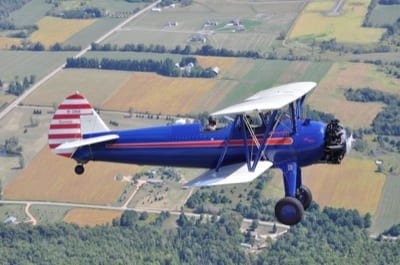 “When Merrill and I started going together, Merrill was a submariner in the Navy, and he heard my Dad call me Miss Muffet one time. Merrill had an engine on the submarine that gave him trouble, so he put a placard on it that read ‘Miss Muffet’ because it was a tradition that guys named the engines. When we restored the Stearman we decided Miss Muffet was a good name for it.”
“When Merrill and I started going together, Merrill was a submariner in the Navy, and he heard my Dad call me Miss Muffet one time. Merrill had an engine on the submarine that gave him trouble, so he put a placard on it that read ‘Miss Muffet’ because it was a tradition that guys named the engines. When we restored the Stearman we decided Miss Muffet was a good name for it.”
Buying the Stearman grew out of a wish.
“Just after getting our licenses in a Cessna 150 in 1981, Merrill said he had always wanted to loop a Stearman,” MaDonna said.
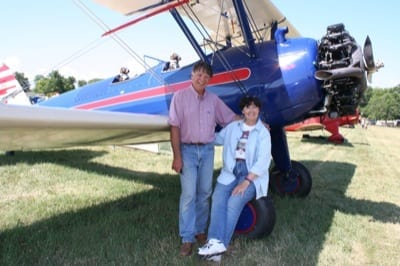 That Thanksgiving the pair were visiting family in Franklin, Indiana, when they met Steve Alcorn, who was connected with the Stearman community and would later go on to fly with the Red Baron Squadron. They asked him if he knew of any Stearman that were for sale. “None were available at the time, but around Christmas Steve called me and said that someone at Franklin wanted to sell his Stearman and would we be interested,” Merrill recalled. “We took our good friend John Hatz, designer and builder of the Hatz biplane, with us in January 1982 to check it out. We had hoped to take a familiarization ride, but the weather was cold and foggy that day. Imagine two new Cessna 150 pilots standing in the fog in front of a hangar as it opens to reveal a 10-foot-tall biplane with a 225-hp round engine high above your head. Speechless.
That Thanksgiving the pair were visiting family in Franklin, Indiana, when they met Steve Alcorn, who was connected with the Stearman community and would later go on to fly with the Red Baron Squadron. They asked him if he knew of any Stearman that were for sale. “None were available at the time, but around Christmas Steve called me and said that someone at Franklin wanted to sell his Stearman and would we be interested,” Merrill recalled. “We took our good friend John Hatz, designer and builder of the Hatz biplane, with us in January 1982 to check it out. We had hoped to take a familiarization ride, but the weather was cold and foggy that day. Imagine two new Cessna 150 pilots standing in the fog in front of a hangar as it opens to reveal a 10-foot-tall biplane with a 225-hp round engine high above your head. Speechless.
“On the way home, John assured us that it ‘was what he said it was,’ and we made the decision to purchase it,” he continued. “I said that if we did not do it, we would always wonder, ‘what if?’
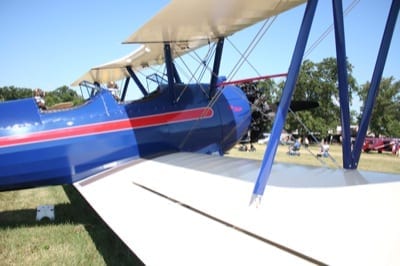 The couple asked Hatz to go back to Indiana in February to pick up the new plane for them at Indianapolis International Airport.
The couple asked Hatz to go back to Indiana in February to pick up the new plane for them at Indianapolis International Airport.
“That’s where it went for the annual,” Merrill said. “It was supposed to be warm, but John got delayed and the weather turned cold again. Because the airplane had no radio, they stopped all of the traffic at Indy for five minutes while they gave John the light signal to take off.”
The two freshly-minted Cessna 150 pilots put their efforts into getting checked out in the vintage taildragger.
“It took us each 13 hours to get checked out, and we wore out a set of new tires,” MaDonna recalled. “John said that if we were going to fly at an airport with pavement, we had to learn on pavement.”
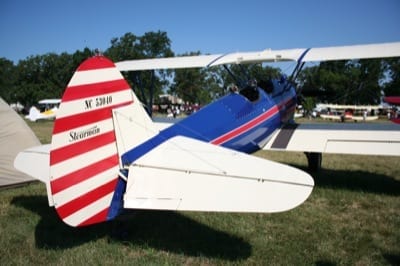 It was a challenge, added Merrill, going from the tricycle gear 100-hp Cessna to the taildragger with the 225 Lycoming R-680 engine, but they did it, becoming the latest in what they are sure is a long line of aviators trained in the airplane.
It was a challenge, added Merrill, going from the tricycle gear 100-hp Cessna to the taildragger with the 225 Lycoming R-680 engine, but they did it, becoming the latest in what they are sure is a long line of aviators trained in the airplane.
According to Merrill, the airplane was a training platform for hundreds of pilots. “The airplane rolled out of the factory in 1941. It served in the military prior to Pearl Harbor and was mustered out in 1945 and sold under the war surplus act. It served the whole war, so it is a true veteran.”
After the war, the airplane passed through the hands of several owners. One of them was a dentist from Oregon, who took the Stearman to airshows to promote good dentistry for children.
“He painted the Pink Panther holding a toothbrush on the rudder,” said MaDonna.
When the McMahans got it, the airplane had a civilian paint job. “The airplane started out with white wings and a blue fuselage and we flew it 10 to 13 years like that,” Merrill explained. “When we put it back together we kept the paint job, except we added the red stripe down the side.”
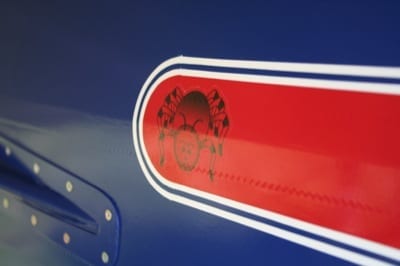 The airplane’s details, such as the 1938-era Stearman logo and the spiders, are vinyl decals. The spiders are easy to miss as they are embedded in the blue paint. The McMahans added a placard to the front cockpit that says “Today is your lucky day” in homage to the dentist because he used to say that to the children he gave rides to. There is also a placard in memory of John Hatz on the side of the plane.
The airplane’s details, such as the 1938-era Stearman logo and the spiders, are vinyl decals. The spiders are easy to miss as they are embedded in the blue paint. The McMahans added a placard to the front cockpit that says “Today is your lucky day” in homage to the dentist because he used to say that to the children he gave rides to. There is also a placard in memory of John Hatz on the side of the plane.
In the cockpits there are are pair of stuffed aviator bears, gifts from friends. “The bears accompany us to Oshkosh every year,” said MaDonna.
 When asked why they didn’t turn the airplane back into a World War II-era trainer, the McMahans just laugh, noting that the Stearman, like so many others from that generation, is retired. Today the mission of the grand old biplane is flying around on the weekends, stopping at airport breakfasts and gatherings.
When asked why they didn’t turn the airplane back into a World War II-era trainer, the McMahans just laugh, noting that the Stearman, like so many others from that generation, is retired. Today the mission of the grand old biplane is flying around on the weekends, stopping at airport breakfasts and gatherings.
“You can eat your way across Wisconsin!” MaDonna laughs.
In July, however, you’ll probably find them at AirVenture, parked in the Vintage Aircraft area.
